engine coolant Abarth 500 2020 Owner handbook (in English)
[x] Cancel search | Manufacturer: ABARTH, Model Year: 2020, Model line: 500, Model: Abarth 500 2020Pages: 196, PDF Size: 3.53 MB
Page 30 of 196
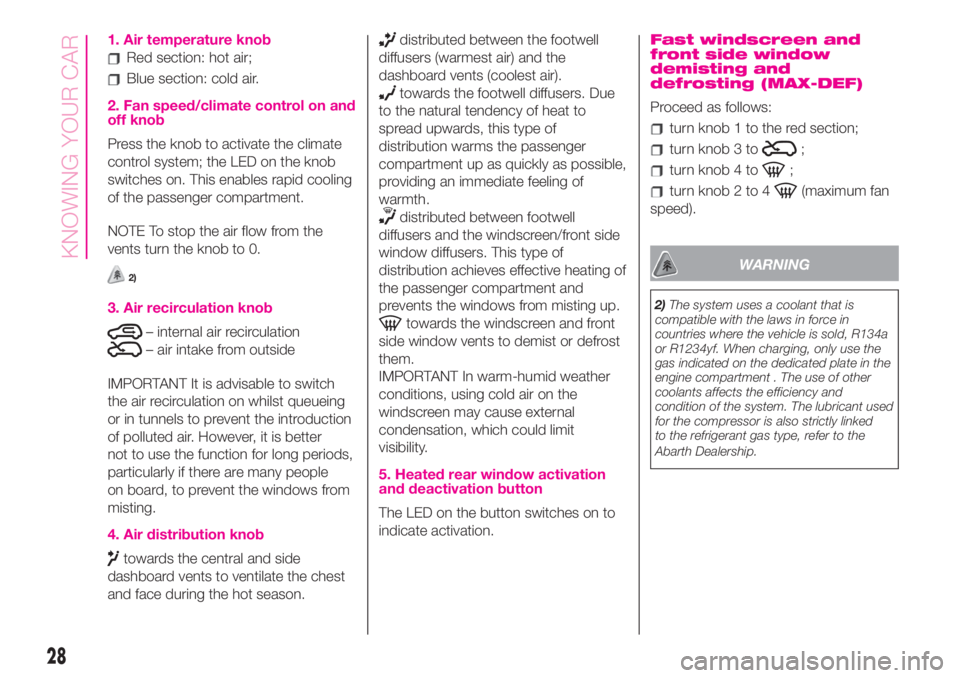
1. Air temperature knob
Red section: hot air;
Blue section: cold air.
2. Fan speed/climate control on and
off knob
Press the knob to activate the climate
control system; the LED on the knob
switches on. This enables rapid cooling
of the passenger compartment.
NOTE To stop the air flow from the
vents turn the knob to 0.
2)
3. Air recirculation knob
– internal air recirculation
– air intake from outside
IMPORTANT It is advisable to switch
the air recirculation on whilst queueing
or in tunnels to prevent the introduction
of polluted air. However, it is better
not to use the function for long periods,
particularly if there are many people
on board, to prevent the windows from
misting.
4. Air distribution knob
towards the central and side
dashboard vents to ventilate the chest
and face during the hot season.
distributed between the footwell
diffusers (warmest air) and the
dashboard vents (coolest air).
towards the footwell diffusers. Due
to the natural tendency of heat to
spread upwards, this type of
distribution warms the passenger
compartment up as quickly as possible,
providing an immediate feeling of
warmth.
distributed between footwell
diffusers and the windscreen/front side
window diffusers. This type of
distribution achieves effective heating of
the passenger compartment and
prevents the windows from misting up.
towards the windscreen and front
side window vents to demist or defrost
them.
IMPORTANT In warm-humid weather
conditions, using cold air on the
windscreen may cause external
condensation, which could limit
visibility.
5. Heated rear window activation
and deactivation button
The LED on the button switches on to
indicate activation.
Fast windscreen and
front side window
demisting and
defrosting (MAX-DEF)
Proceed as follows:
turn knob 1 to the red section;
turn knob 3 to;
turn knob 4 to;
turn knob 2 to 4(maximum fan
speed).
WARNING
2)The system uses a coolant that is
compatible with the laws in force in
countries where the vehicle is sold, R134a
or R1234yf. When charging, only use the
gas indicated on the dedicated plate in the
engine compartment . The use of other
coolants affects the efficiency and
condition of the system. The lubricant used
for the compressor is also strictly linked
to the refrigerant gas type, refer to the
Abarth Dealership.
28
KNOWING YOUR CAR
Page 32 of 196
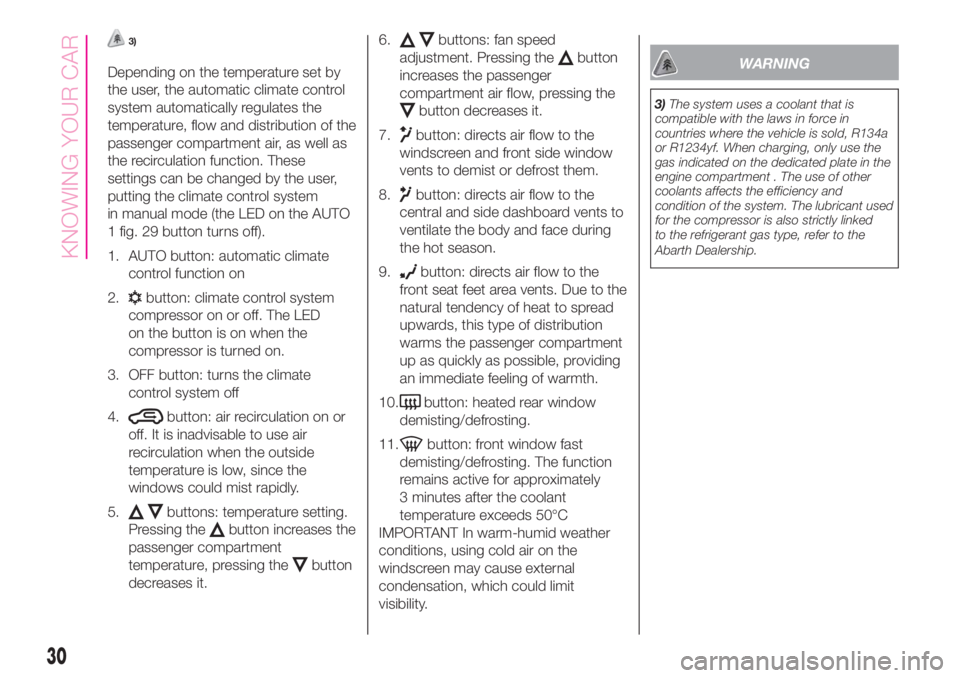
3)
Depending on the temperature set by
the user, the automatic climate control
system automatically regulates the
temperature, flow and distribution of the
passenger compartment air, as well as
the recirculation function. These
settings can be changed by the user,
putting the climate control system
in manual mode (the LED on the AUTO
1 fig. 29 button turns off).
1. AUTO button: automatic climate
control function on
2.
button: climate control system
compressor on or off. The LED
on the button is on when the
compressor is turned on.
3. OFF button: turns the climate
control system off
4.
button: air recirculation on or
off. It is inadvisable to use air
recirculation when the outside
temperature is low, since the
windows could mist rapidly.
5.
buttons: temperature setting.
Pressing the
button increases the
passenger compartment
temperature, pressing the
button
decreases it.6.
buttons: fan speed
adjustment. Pressing the
button
increases the passenger
compartment air flow, pressing the
button decreases it.
7.
button: directs air flow to the
windscreen and front side window
vents to demist or defrost them.
8.
button: directs air flow to the
central and side dashboard vents to
ventilate the body and face during
the hot season.
9.
button: directs air flow to the
front seat feet area vents. Due to the
natural tendency of heat to spread
upwards, this type of distribution
warms the passenger compartment
up as quickly as possible, providing
an immediate feeling of warmth.
10.
button: heated rear window
demisting/defrosting.
11.
button: front window fast
demisting/defrosting. The function
remains active for approximately
3 minutes after the coolant
temperature exceeds 50°C
IMPORTANT In warm-humid weather
conditions, using cold air on the
windscreen may cause external
condensation, which could limit
visibility.
WARNING
3)The system uses a coolant that is
compatible with the laws in force in
countries where the vehicle is sold, R134a
or R1234yf. When charging, only use the
gas indicated on the dedicated plate in the
engine compartment . The use of other
coolants affects the efficiency and
condition of the system. The lubricant used
for the compressor is also strictly linked
to the refrigerant gas type, refer to the
Abarth Dealership.
30
KNOWING YOUR CAR
Page 42 of 196
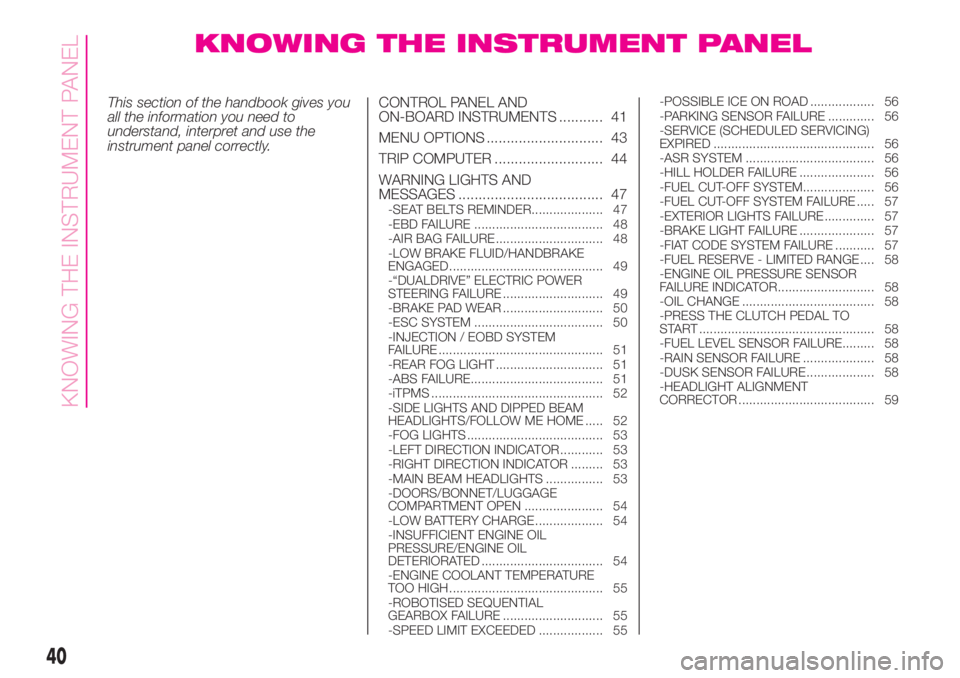
KNOWING THE INSTRUMENT PANEL
This section of the handbook gives you
all the information you need to
understand, interpret and use the
instrument panel correctly.CONTROL PANEL AND
ON-BOARD INSTRUMENTS ........... 41
MENU OPTIONS ............................. 43
TRIP COMPUTER ........................... 44
WARNING LIGHTS AND
MESSAGES .................................... 47
-SEAT BELTS REMINDER.................... 47
-EBD FAILURE .................................... 48
-AIR BAG FAILURE .............................. 48
-LOW BRAKE FLUID/HANDBRAKE
ENGAGED........................................... 49
-“DUALDRIVE” ELECTRIC POWER
STEERING FAILURE ............................ 49
-BRAKE PAD WEAR ............................ 50
-ESC SYSTEM .................................... 50
-INJECTION / EOBD SYSTEM
FAILURE .............................................. 51
-REAR FOG LIGHT .............................. 51
-ABS FAILURE..................................... 51
-iTPMS ................................................ 52
-SIDE LIGHTS AND DIPPED BEAM
HEADLIGHTS/FOLLOW ME HOME ..... 52
-FOG LIGHTS ...................................... 53
-LEFT DIRECTION INDICATOR ............ 53
-RIGHT DIRECTION INDICATOR ......... 53
-MAIN BEAM HEADLIGHTS ................ 53
-DOORS/BONNET/LUGGAGE
COMPARTMENT OPEN ...................... 54
-LOW BATTERY CHARGE ................... 54
-INSUFFICIENT ENGINE OIL
PRESSURE/ENGINE OIL
DETERIORATED .................................. 54
-ENGINE COOLANT TEMPERATURE
TOO HIGH........................................... 55
-ROBOTISED SEQUENTIAL
GEARBOX FAILURE ............................ 55
-SPEED LIMIT EXCEEDED .................. 55-POSSIBLE ICE ON ROAD .................. 56
-PARKING SENSOR FAILURE ............. 56
-SERVICE (SCHEDULED SERVICING)
EXPIRED ............................................. 56
-ASR SYSTEM .................................... 56
-HILL HOLDER FAILURE ..................... 56
-FUEL CUT-OFF SYSTEM.................... 56
-FUEL CUT-OFF SYSTEM FAILURE ..... 57
-EXTERIOR LIGHTS FAILURE .............. 57
-BRAKE LIGHT FAILURE ..................... 57
-FIAT CODE SYSTEM FAILURE ........... 57
-FUEL RESERVE - LIMITED RANGE .... 58
-ENGINE OIL PRESSURE SENSOR
FAILURE INDICATOR........................... 58
-OIL CHANGE ..................................... 58
-PRESS THE CLUTCH PEDAL TO
START ................................................. 58
-FUEL LEVEL SENSOR FAILURE......... 58
-RAIN SENSOR FAILURE .................... 58
-DUSK SENSOR FAILURE ................... 58
-HEADLIGHT ALIGNMENT
CORRECTOR ...................................... 59
40
KNOWING THE INSTRUMENT PANEL
Page 43 of 196
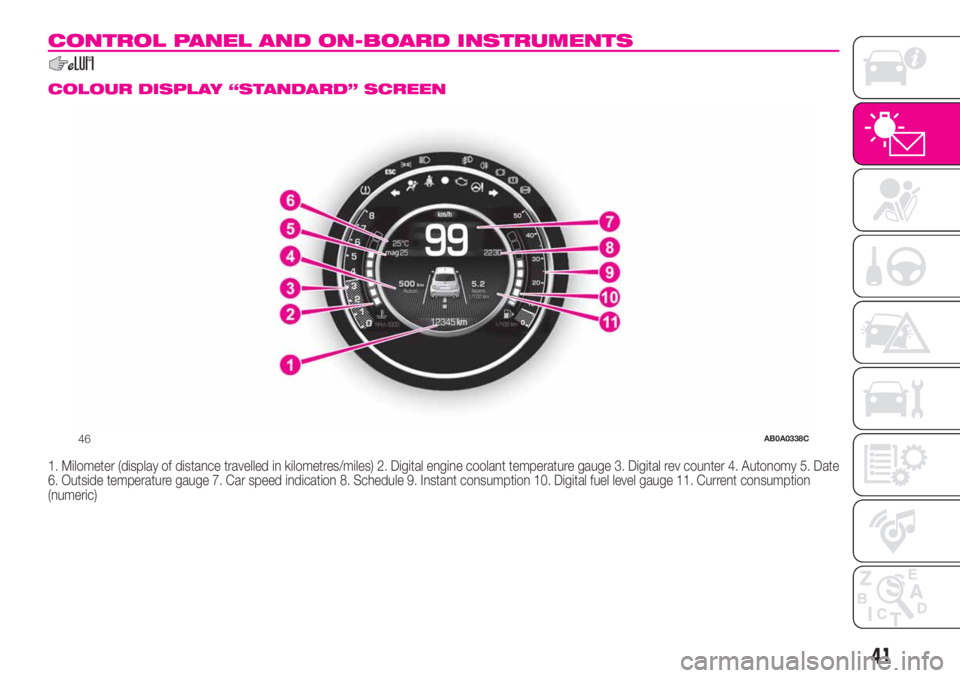
CONTROL PANEL AND ON-BOARD INSTRUMENTS
.
COLOUR DISPLAY “STANDARD” SCREEN
1. Milometer (display of distance travelled in kilometres/miles) 2. Digital engine coolant temperature gauge 3. Digital rev counter 4. Autonomy 5. Date
6. Outside temperature gauge 7. Car speed indication 8. Schedule 9. Instant consumption 10. Digital fuel level gauge 11. Current consumption
(numeric)
46AB0A0338C
41
Page 44 of 196
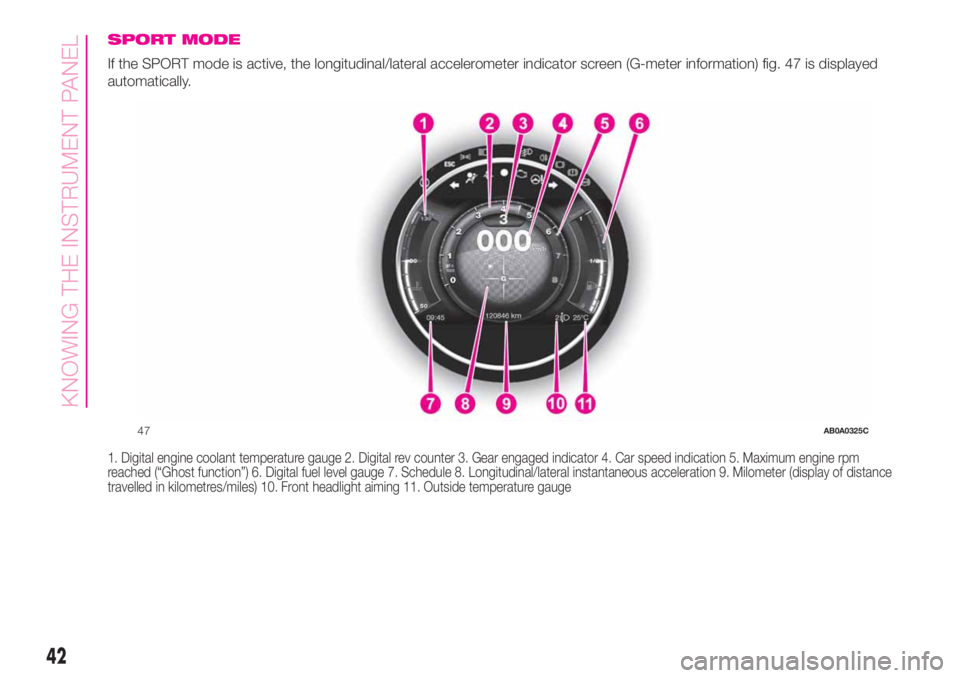
SPORT MODE
If the SPORT mode is active, the longitudinal/lateral accelerometer indicator screen (G-meter information) fig. 47 is displayed
automatically.
1. Digital engine coolant temperature gauge 2. Digital rev counter 3. Gear engaged indicator 4. Car speed indication 5. Maximum engine rpm
reached (“Ghost function”) 6. Digital fuel level gauge 7. Schedule 8. Longitudinal/lateral instantaneous acceleration 9. Milometer (display of distance
travelled in kilometres/miles) 10. Front headlight aiming 11. Outside temperature gauge
47AB0A0325C
42
KNOWING THE INSTRUMENT PANEL
Page 57 of 196
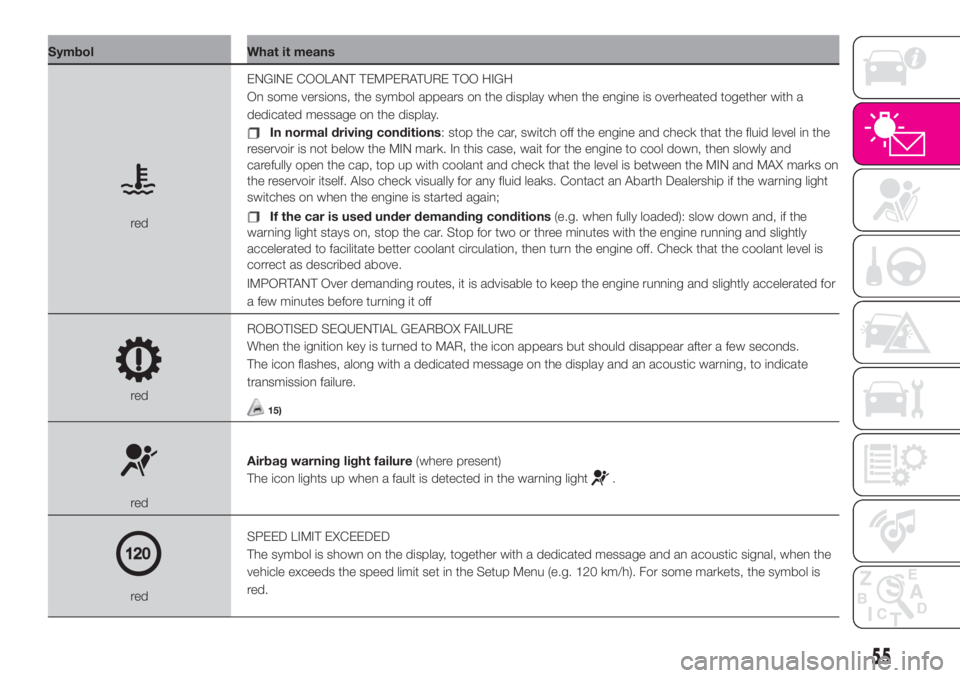
Symbol What it means
redENGINE COOLANT TEMPERATURE TOO HIGH
On some versions, the symbol appears on the display when the engine is overheated together with a
dedicated message on the display.
In normal driving conditions: stop the car, switch off the engine and check that the fluid level in the
reservoir is not below the MIN mark. In this case, wait for the engine to cool down, then slowly and
carefully open the cap, top up with coolant and check that the level is between the MIN and MAX marks on
the reservoir itself. Also check visually for any fluid leaks. Contact an Abarth Dealership if the warning light
switches on when the engine is started again;
If the car is used under demanding conditions(e.g. when fully loaded): slow down and, if the
warning light stays on, stop the car. Stop for two or three minutes with the engine running and slightly
accelerated to facilitate better coolant circulation, then turn the engine off. Check that the coolant level is
correct as described above.
IMPORTANT Over demanding routes, it is advisable to keep the engine running and slightly accelerated for
a few minutes before turning it off
redROBOTISED SEQUENTIAL GEARBOX FAILURE
When the ignition key is turned to MAR, the icon appears but should disappear after a few seconds.
The icon flashes, along with a dedicated message on the display and an acoustic warning, to indicate
transmission failure.15)
redAirbag warning light failure(where present)
The icon lights up when a fault is detected in the warning light
.
redSPEED LIMIT EXCEEDED
The symbol is shown on the display, together with a dedicated message and an acoustic signal, when the
vehicle exceeds the speed limit set in the Setup Menu (e.g. 120 km/h). For some markets, the symbol is
red.
55
Page 87 of 196
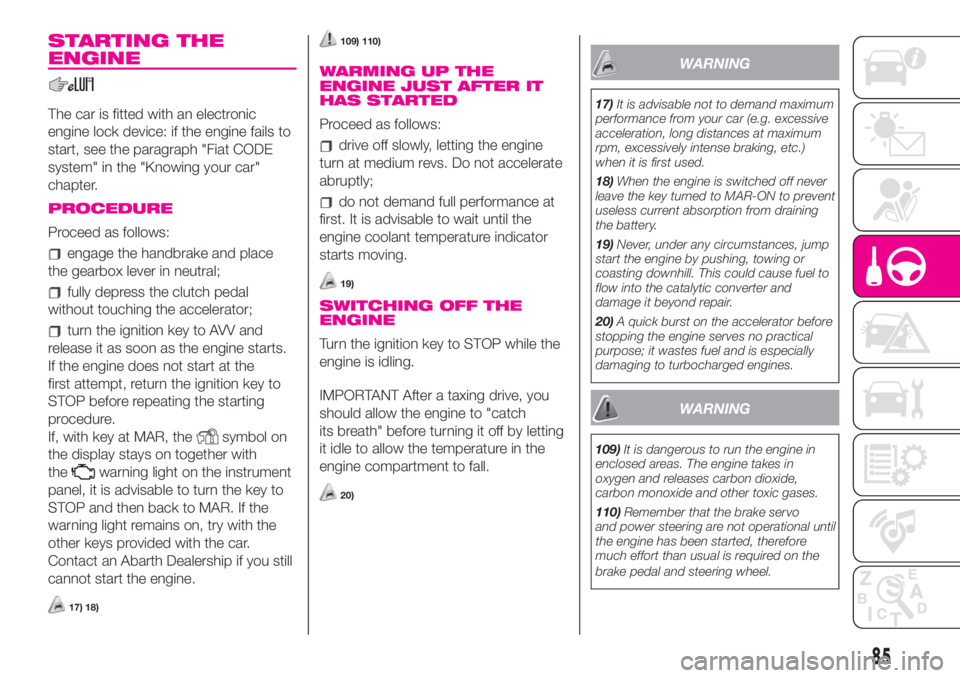
STARTING THE
ENGINE
The car is fitted with an electronic
engine lock device: if the engine fails to
start, see the paragraph "Fiat CODE
system" in the "Knowing your car"
chapter.
PROCEDURE
Proceed as follows:
engage the handbrake and place
the gearbox lever in neutral;
fully depress the clutch pedal
without touching the accelerator;
turn the ignition key to AVV and
release it as soon as the engine starts.
If the engine does not start at the
first attempt, return the ignition key to
STOP before repeating the starting
procedure.
If, with key at MAR, the
symbol on
the display stays on together with
the
warning light on the instrument
panel, it is advisable to turn the key to
STOP and then back to MAR. If the
warning light remains on, try with the
other keys provided with the car.
Contact an Abarth Dealership if you still
cannot start the engine.
17) 18)
109) 110)
WARMING UP THE
ENGINE JUST AFTER IT
HAS STARTED
Proceed as follows:
drive off slowly, letting the engine
turn at medium revs. Do not accelerate
abruptly;
do not demand full performance at
first. It is advisable to wait until the
engine coolant temperature indicator
starts moving.
19)
SWITCHING OFF THE
ENGINE
Turn the ignition key to STOP while the
engine is idling.
IMPORTANT After a taxing drive, you
should allow the engine to "catch
its breath" before turning it off by letting
it idle to allow the temperature in the
engine compartment to fall.
20)
WARNING
17)It is advisable not to demand maximum
performance from your car (e.g. excessive
acceleration, long distances at maximum
rpm, excessively intense braking, etc.)
when it is first used.
18)When the engine is switched off never
leave the key turned to MAR-ON to prevent
useless current absorption from draining
the battery.
19)Never, under any circumstances, jump
start the engine by pushing, towing or
coasting downhill. This could cause fuel to
flow into the catalytic converter and
damage it beyond repair.
20)A quick burst on the accelerator before
stopping the engine serves no practical
purpose; it wastes fuel and is especially
damaging to turbocharged engines.
WARNING
109)It is dangerous to run the engine in
enclosed areas. The engine takes in
oxygen and releases carbon dioxide,
carbon monoxide and other toxic gases.
110)Remember that the brake servo
and power steering are not operational until
the engine has been started, therefore
much effort than usual is required on the
brake pedal and steering wheel.
85
Page 122 of 196
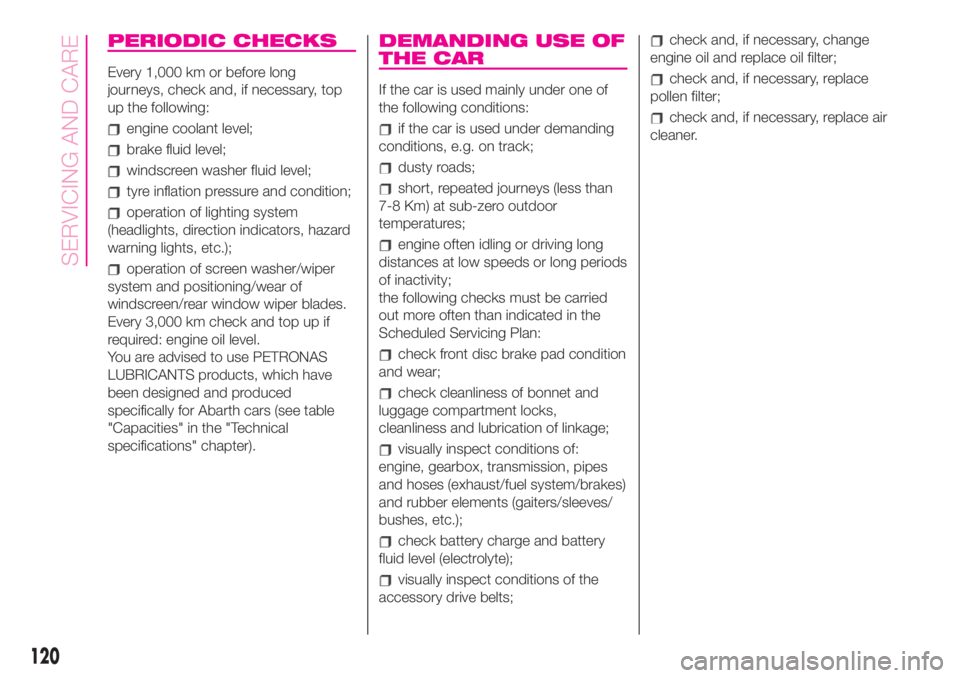
PERIODIC CHECKS
Every 1,000 km or before long
journeys, check and, if necessary, top
up the following:
engine coolant level;
brake fluid level;
windscreen washer fluid level;
tyre inflation pressure and condition;
operation of lighting system
(headlights, direction indicators, hazard
warning lights, etc.);
operation of screen washer/wiper
system and positioning/wear of
windscreen/rear window wiper blades.
Every 3,000 km check and top up if
required: engine oil level.
You are advised to use PETRONAS
LUBRICANTS products, which have
been designed and produced
specifically for Abarth cars (see table
"Capacities" in the "Technical
specifications" chapter).
DEMANDING USE OF
THE CAR
If the car is used mainly under one of
the following conditions:
if the car is used under demanding
conditions, e.g. on track;
dusty roads;
short, repeated journeys (less than
7-8 Km) at sub-zero outdoor
temperatures;
engine often idling or driving long
distances at low speeds or long periods
of inactivity;
the following checks must be carried
out more often than indicated in the
Scheduled Servicing Plan:
check front disc brake pad condition
and wear;
check cleanliness of bonnet and
luggage compartment locks,
cleanliness and lubrication of linkage;
visually inspect conditions of:
engine, gearbox, transmission, pipes
and hoses (exhaust/fuel system/brakes)
and rubber elements (gaiters/sleeves/
bushes, etc.);
check battery charge and battery
fluid level (electrolyte);
visually inspect conditions of the
accessory drive belts;
check and, if necessary, change
engine oil and replace oil filter;
check and, if necessary, replace
pollen filter;
check and, if necessary, replace air
cleaner.
120
SERVICING AND CARE
Page 123 of 196
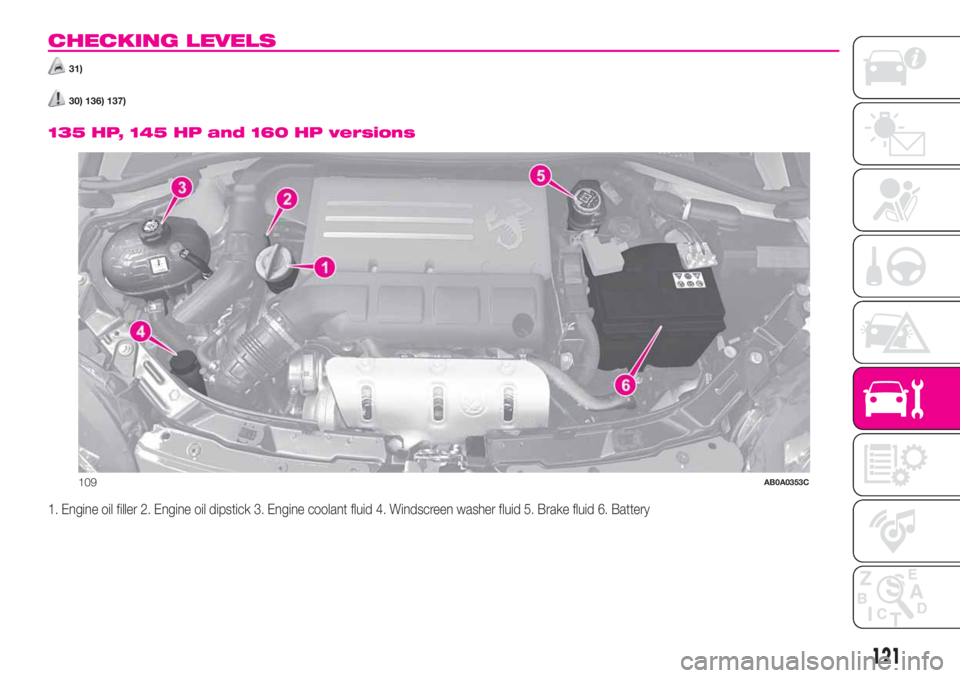
CHECKING LEVELS
31)
30) 136) 137).
135 HP, 145 HP and 160 HP versions
1. Engine oil filler 2. Engine oil dipstick 3. Engine coolant fluid 4. Windscreen washer fluid 5. Brake fluid 6. Battery
109AB0A0353C
121
Page 124 of 196
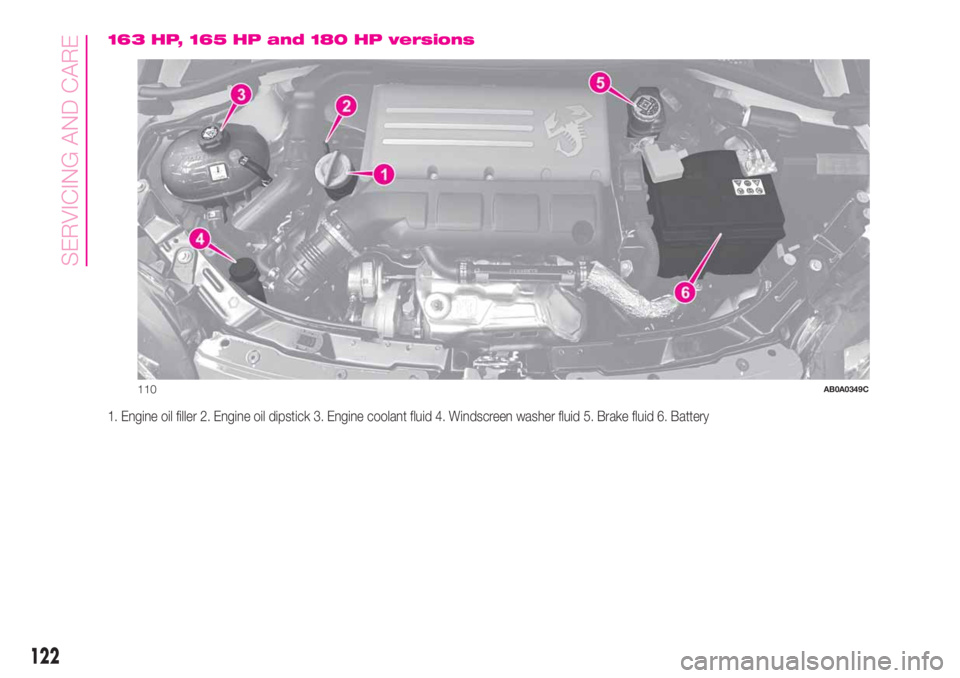
163 HP, 165 HP and 180 HP versions
1. Engine oil filler 2. Engine oil dipstick 3. Engine coolant fluid 4. Windscreen washer fluid 5. Brake fluid 6. Battery
110AB0A0349C
122
SERVICING AND CARE